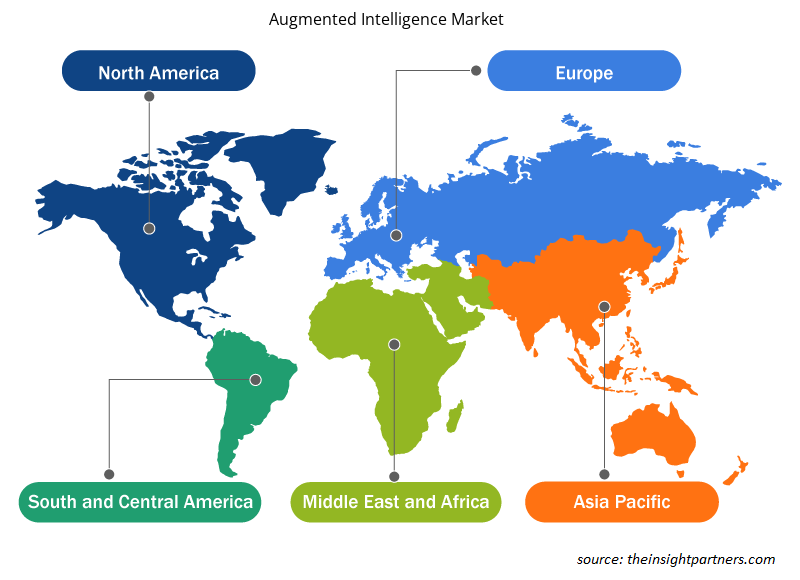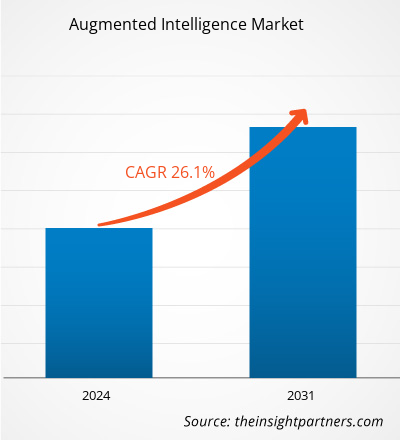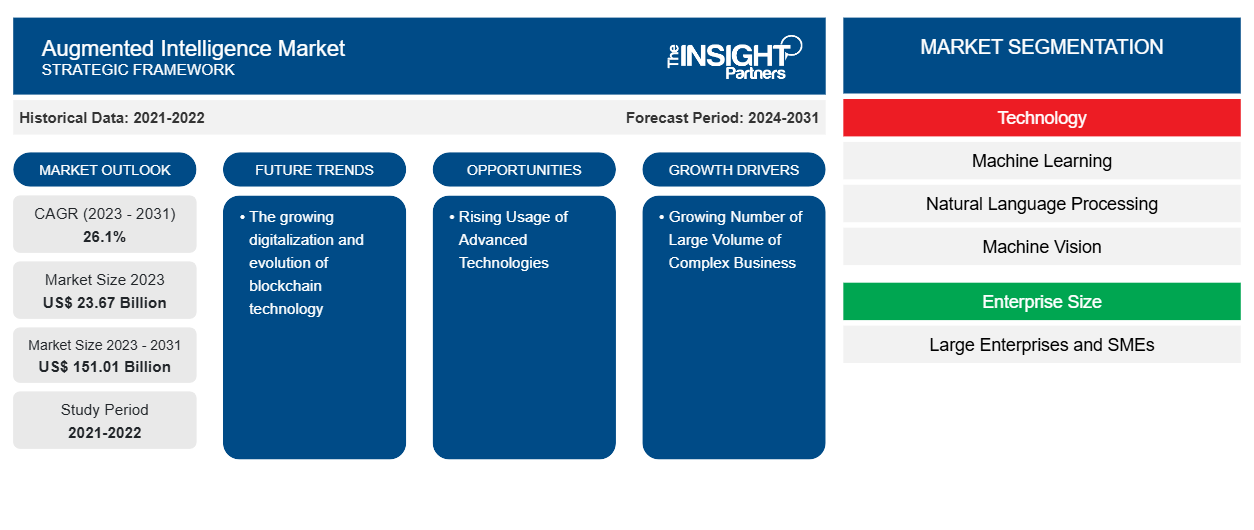Der Markt für Augmented Intelligence soll von 23,67 Milliarden US-Dollar im Jahr 2023 auf 151,01 Milliarden US-Dollar im Jahr 2031 anwachsen. Der Markt soll zwischen 2023 und 2031 eine durchschnittliche jährliche Wachstumsrate (CAGR) von 26,1 % verzeichnen. Die zunehmende Digitalisierung und Weiterentwicklung der Blockchain-Technologie dürfte ein wichtiger Trend auf dem Markt für Augmented Intelligence bleiben.
Augmented Intelligence Marktanalyse
Der Markt für Augmented Intelligence wächst aufgrund der wachsenden Anzahl großer Mengen komplexer Geschäftsdaten und der expandierenden Branchen BFSI, IT & Telekommunikation sowie Einzelhandel und E-Commerce rasant. Der Markt wächst stetig, angetrieben durch die zunehmende Einführung von Augmented Intelligence bei KMU. Darüber hinaus bieten die zunehmende Nutzung fortschrittlicher Technologien und die zunehmende Einführung cloudbasierter Lösungen bei Unternehmen lukrative Möglichkeiten für Marktwachstum.
Augmented Intelligence Marktübersicht
Augmented Intelligence ist eine Art künstlicher Intelligenz, die sich auf die unterstützenden Fähigkeiten der KI konzentriert. Darüber hinaus wird Augmented Intelligence entwickelt, um Organisationen dabei zu unterstützen, im Geschäftsleben und im täglichen Leben genauere, datengesteuerte Entscheidungen zu treffen. Darüber hinaus wird Augmented Intelligence von Unternehmen eingesetzt, um die Leistung ihrer Mitarbeiter zu verbessern, und hilft der Organisation dabei, die Verbesserungsbereiche der Mitarbeiter zu verstehen, was den Markt antreibt. Darüber hinaus ist Augmented Intelligence die effektivste Technik, um eine große Sammlung von Sicherheitsdaten zu nutzen und zu priorisieren, indem sie Unternehmen prädiktive Analysen zur Verfügung stellt.
Passen Sie diesen Bericht Ihren Anforderungen an
Sie erhalten kostenlos individuelle Anpassungen an jedem Bericht, einschließlich Teilen dieses Berichts oder einer Analyse auf Länderebene, eines Excel-Datenpakets sowie tolle Angebote und Rabatte für Start-ups und Universitäten.
-
Holen Sie sich die wichtigsten Markttrends aus diesem Bericht.Dieses KOSTENLOSE Beispiel umfasst eine Datenanalyse von Markttrends bis hin zu Schätzungen und Prognosen.
Treiber und Chancen des Augmented Intelligence-Marktes
Die wachsende Zahl großer Mengen komplexer Geschäftsdaten treibt den Markt an
Technologien der erweiterten Intelligenz wie maschinelles Lernen und Verarbeitung natürlicher Sprache werden für die Datenanalyse immer wichtiger. Erweiterte Intelligenz ermöglicht die Analyse organisierter, halbstrukturierter und unstrukturierter Datenquellen, die in Unternehmen gespeichert sind. Die Vielfalt und das hohe Volumen der erstellten Daten werden in den kommenden Jahren voraussichtlich aufgrund der expandierenden Branchen und der Entwicklung digitaler Technologien in allen Unternehmensabläufen erheblich zunehmen. Dies erhöht die Nachfrage der Unternehmen nach Lösungen für erweiterte Intelligenz, um ihre großen Datenmengen effektiv und effizient zu verwalten. Es wird jedoch erwartet, dass das wachsende Volumen komplexer Daten den Markt für erweiterte Intelligenz im erwarteten Zeitraum ankurbeln wird.
Steigende Nutzung fortschrittlicher Technologien – eine Chance auf dem Markt für erweiterte Intelligenz
Die zunehmende Nutzung fortschrittlicher Technologien wie künstliche Intelligenz, maschinelles Lernen und natürliche Sprachverarbeitung schafft im Prognosezeitraum Chancen für Marktwachstum. Viele Branchen wie IT und Telekommunikation, Einzelhandel und E-Commerce, BFSI, Gesundheitswesen und andere generieren riesige Datenmengen und benötigen fortschrittliche Technologien zur Analyse dieser Daten in Echtzeit, was die Nachfrage nach Augmented-Intelligence-Lösungen erhöht. Branchen übernehmen neue Technologien wie künstliche Intelligenz, maschinelles Lernen und natürliche Sprachverarbeitung, um riesige Datenmengen zu analysieren und in Echtzeit effektive Entscheidungen zu treffen. Diese Tools haben den Prozess der Gewinnung von Erkenntnissen aus Daten vereinfacht, was ihre Akzeptanz erhöht und Chancen auf dem Markt schafft.BFSI, healthcare, and others, are generating vast volumes of data and require advanced technologies for analyzing this data in real-time, which increases the demand for augmented intelligence solutions. Industries are adopting new technologies such as artificial intelligence, machine learning, and natural language processing for analyzing vast data by making effective decisions in real time. These tools have simplified the process of extracting insights from data, which increases its adoption and creates opportunities in the market.
Segmentierungsanalyse des Augmented Intelligence-Marktberichts
Wichtige Segmente, die zur Ableitung der Augmented Intelligence-Marktanalyse beigetragen haben, sind Technologie, Unternehmensgröße und Endbenutzer
- Basierend auf der Technologie ist der Markt für erweiterte Intelligenz in maschinelles Lernen, Verarbeitung natürlicher Sprache, maschinelles Sehen, kontextsensitives Computing und andere unterteilt. Das Segment des maschinellen Lernens hatte im Jahr 2023 einen größeren Marktanteil.
- In Bezug auf die Unternehmensgröße ist der Markt in Großunternehmen und KMU segmentiert. Das KMU-Segment hatte im Jahr 2023 einen größeren Marktanteil.
- In Bezug auf den Endbenutzer wird der Markt in IT und Telekommunikation, Einzelhandel und E-Commerce, BFSI, Gesundheitswesen und andere unterteilt. Das BFSI-Segment hatte im Jahr 2023 einen größeren Marktanteil.
Augmented Intelligence Marktanteilsanalyse nach Geografie
Der geografische Umfang des Marktberichts für erweiterte Intelligenz ist hauptsächlich in fünf Regionen unterteilt: Nordamerika, Asien-Pazifik, Europa, Naher Osten und Afrika sowie Südamerika/Süd- und Mittelamerika.
In Bezug auf den Umsatz hatte Nordamerika den größten Marktanteil im Bereich Augmented Intelligence, was auf den technologischen Fortschritt und die Präsenz wichtiger Akteure wie IBM Corporation, Microsoft Corporation, TIBCO Software Inc., Salesforce.com, Inc. und MicroStrategy Incorporated zurückzuführen ist. Diese Akteure investieren erheblich in die Einführung fortschrittlicher Technologien wie KI, ML und NLP und entwickeln diese Technologien kontinuierlich weiter, indem sie zusätzliche Funktionen hinzufügen. Die steigende Nachfrage nach Cloud-basierter Augmented Intelligence in Branchen wie IT und Telekommunikation , BFSI, Einzelhandel und E-Commerce, Gesundheitswesen und anderen dürfte den Markt in Nordamerika ankurbeln.
Regionale Einblicke in den Augmented Intelligence-Markt
Die regionalen Trends und Faktoren, die den Markt für erweiterte Intelligenz im Prognosezeitraum beeinflussen, wurden von den Analysten von Insight Partners ausführlich erläutert. In diesem Abschnitt werden auch die Marktsegmente und die Geografie für erweiterte Intelligenz in Nordamerika, Europa, im asiatisch-pazifischen Raum, im Nahen Osten und Afrika sowie in Süd- und Mittelamerika erörtert.

- Holen Sie sich die regionalspezifischen Daten für den Augmented Intelligence-Markt
Umfang des Marktberichts zur erweiterten Intelligenz
| Berichtsattribut | Details |
|---|---|
| Marktgröße im Jahr 2023 | 23,67 Milliarden US-Dollar |
| Marktgröße bis 2031 | 151,01 Milliarden US-Dollar |
| Globale CAGR (2023 - 2031) | 26,1 % |
| Historische Daten | 2021-2022 |
| Prognosezeitraum | 2024–2031 |
| Abgedeckte Segmente |
Nach Technologie
|
| Abgedeckte Regionen und Länder |
Nordamerika
|
| Marktführer und wichtige Unternehmensprofile |
|
Dichte der Marktteilnehmer für Augmented Intelligence: Die Auswirkungen auf die Geschäftsdynamik verstehen
Der Markt für Augmented Intelligence wächst rasant, angetrieben durch die steigende Nachfrage der Endnutzer aufgrund von Faktoren wie sich entwickelnden Verbraucherpräferenzen, technologischen Fortschritten und einem größeren Bewusstsein für die Vorteile des Produkts. Mit steigender Nachfrage erweitern Unternehmen ihr Angebot, entwickeln Innovationen, um die Bedürfnisse der Verbraucher zu erfüllen, und nutzen neue Trends, was das Marktwachstum weiter ankurbelt.
Die Marktteilnehmerdichte bezieht sich auf die Verteilung der Firmen oder Unternehmen, die in einem bestimmten Markt oder einer bestimmten Branche tätig sind. Sie gibt an, wie viele Wettbewerber (Marktteilnehmer) in einem bestimmten Marktraum im Verhältnis zu seiner Größe oder seinem gesamten Marktwert präsent sind.
Die wichtigsten auf dem Markt für erweiterte Intelligenz tätigen Unternehmen sind:
- IBM Corporation
- Microsoft Corporation
- SAP SE
- TIBCO Software Inc.
- Sisense Inc.
- Salesforce.com, Inc.
Haftungsausschluss : Die oben aufgeführten Unternehmen sind nicht in einer bestimmten Reihenfolge aufgeführt.

- Erhalten Sie einen Überblick über die wichtigsten Akteure auf dem Markt für erweiterte Intelligenz
Augmented Intelligence-Marktnachrichten und aktuelle Entwicklungen
Der Markt für erweiterte Intelligenz wird durch die Erhebung qualitativer und quantitativer Daten nach Primär- und Sekundärforschung bewertet, die wichtige Unternehmensveröffentlichungen, Verbandsdaten und Datenbanken umfasst. Im Folgenden finden Sie eine Liste der Entwicklungen auf dem Markt für erweiterte Intelligenz und Strategien:
- Im September 2023 stellte Oracle Corp heute neue KI-gestützte Funktionen in der Oracle Analytics Cloud vor. Die neuen Self-Service-KI-Funktionen, darunter generative KI-Assistenten und erweiterte Analysen, helfen Unternehmen dabei, den Einfluss von Daten auf die Entscheidungsfindung zu verbessern. (Quelle: Oracle Corp, Pressemitteilung, 2023)
Marktbericht zu erweiterter Intelligenz – Abdeckung und Ergebnisse
Der Bericht „Marktgröße und Prognose für Augmented Intelligence (2021–2031)“ bietet eine detaillierte Analyse des Marktes, die die folgenden Bereiche abdeckt:
- Marktgröße und Prognose auf globaler, regionaler und Länderebene für alle wichtigen Marktsegmente, die im Rahmen des Projekts abgedeckt sind
- Marktdynamik wie Treiber, Beschränkungen und wichtige Chancen
- Wichtige Zukunftstrends
- Detaillierte PEST/Porters Five Forces- und SWOT-Analyse
- Globale und regionale Marktanalyse mit wichtigen Markttrends, wichtigen Akteuren, Vorschriften und aktuellen Marktentwicklungen
- Branchenlandschaft und Wettbewerbsanalyse, einschließlich Marktkonzentration, Heatmap-Analyse, prominenten Akteuren und aktuellen Entwicklungen
- Detaillierte Firmenprofile
- Historische Analyse (2 Jahre), Basisjahr, Prognose (7 Jahre) mit CAGR
- PEST- und SWOT-Analyse
- Marktgröße Wert/Volumen – Global, Regional, Land
- Branchen- und Wettbewerbslandschaft
- Excel-Datensatz
Aktuelle Berichte
Erfahrungsberichte
Grund zum Kauf
- Fundierte Entscheidungsfindung
- Marktdynamik verstehen
- Wettbewerbsanalyse
- Kundeneinblicke
- Marktprognosen
- Risikominimierung
- Strategische Planung
- Investitionsbegründung
- Identifizierung neuer Märkte
- Verbesserung von Marketingstrategien
- Steigerung der Betriebseffizienz
- Anpassung an regulatorische Trends























 Kostenlose Probe anfordern für - Markt für erweiterte Intelligenz
Kostenlose Probe anfordern für - Markt für erweiterte Intelligenz